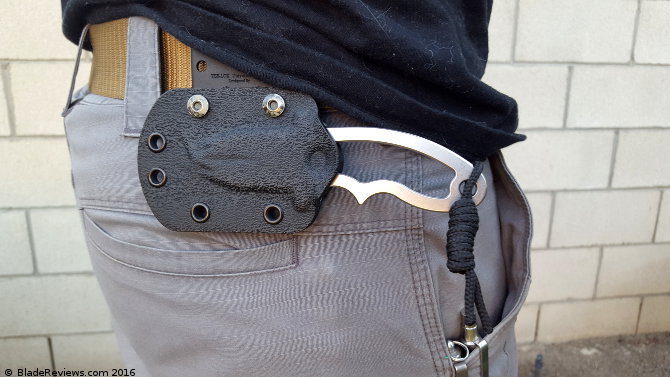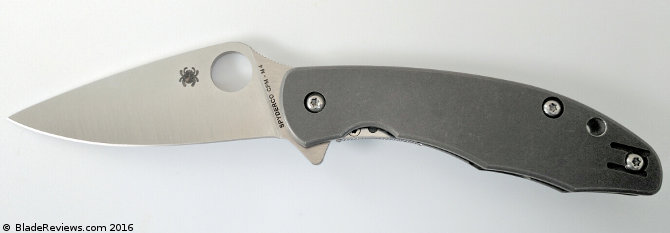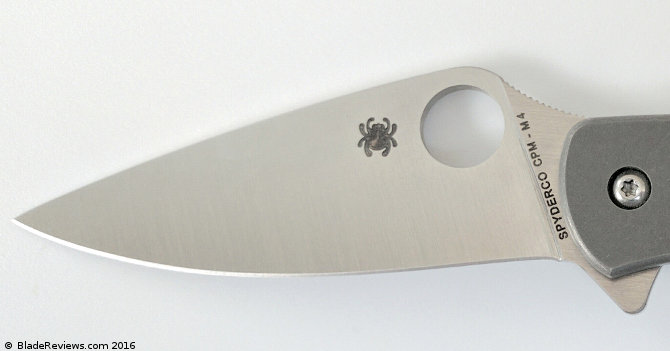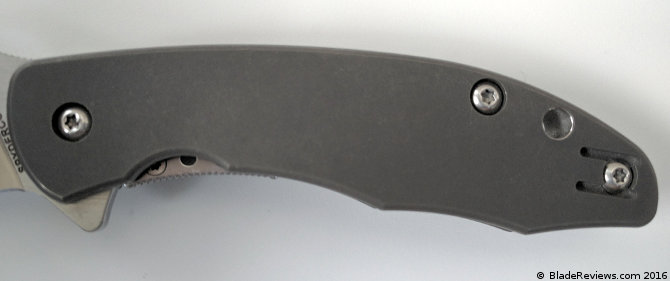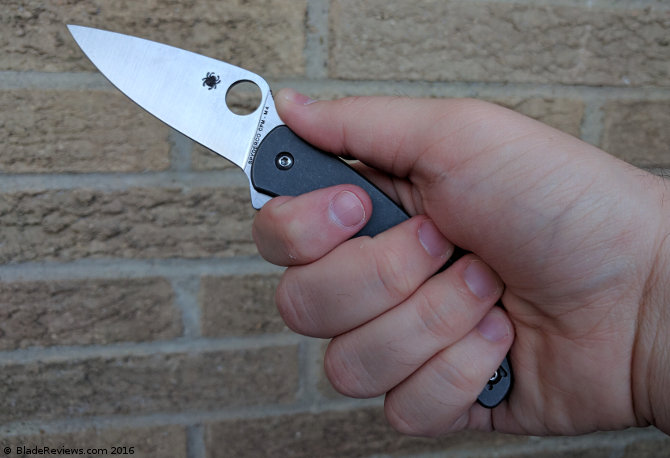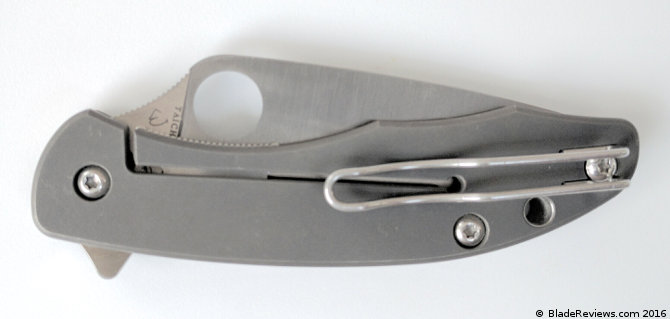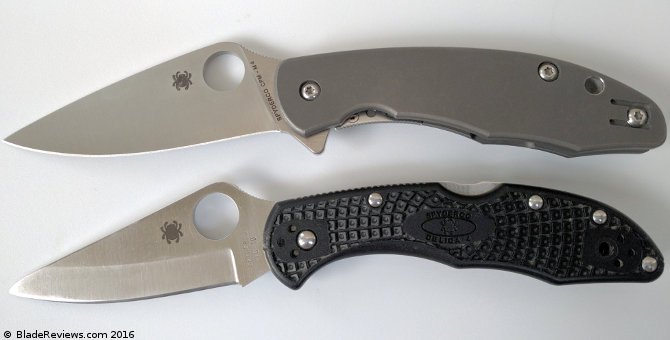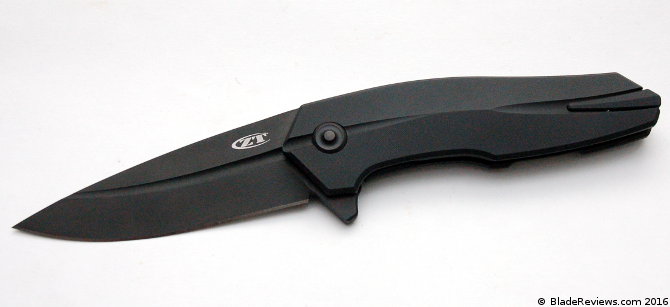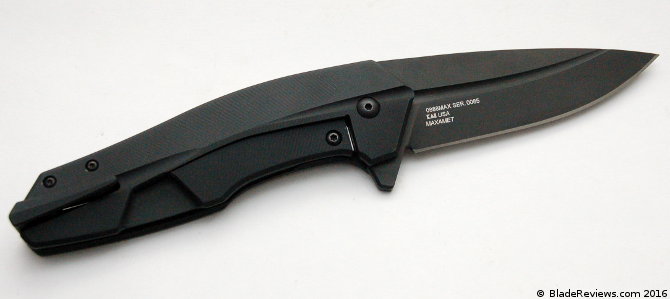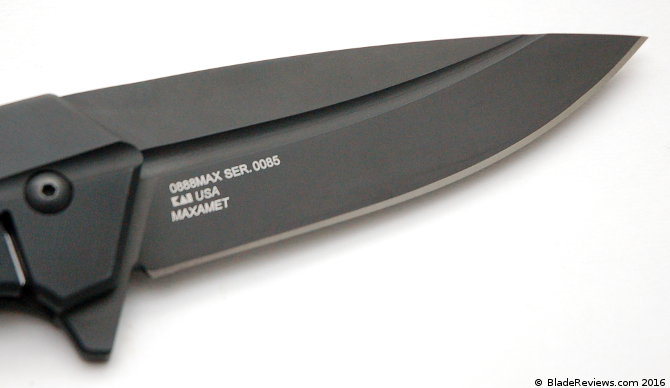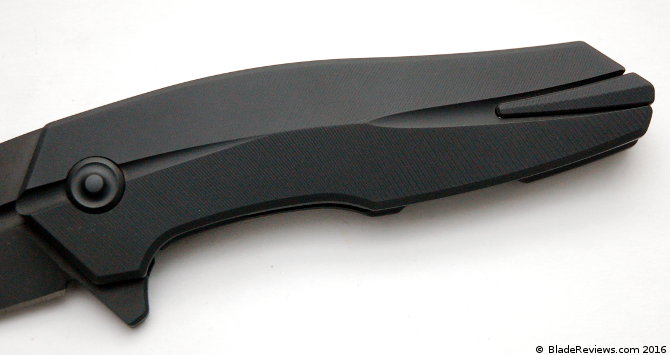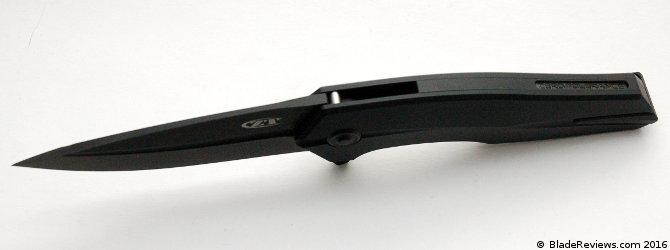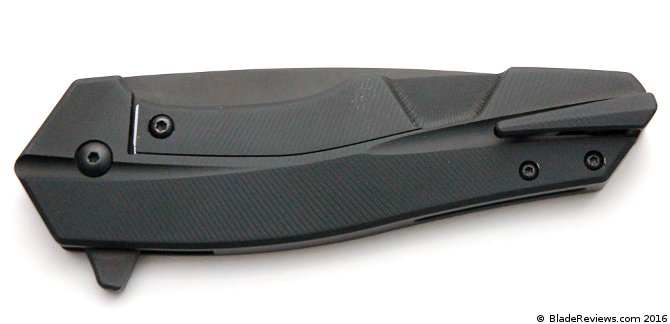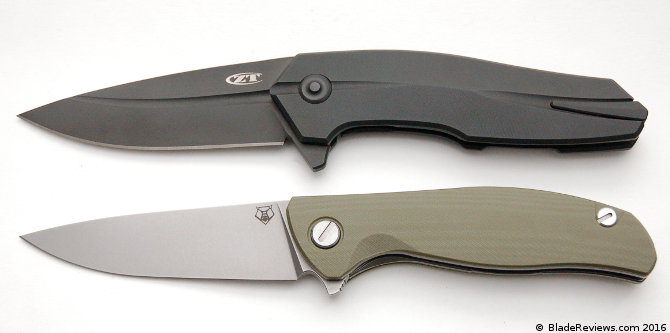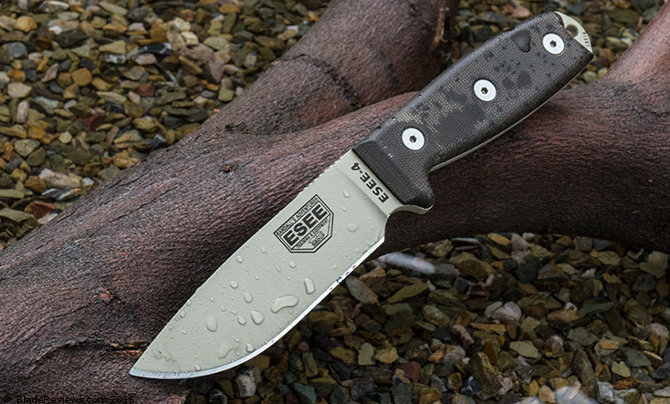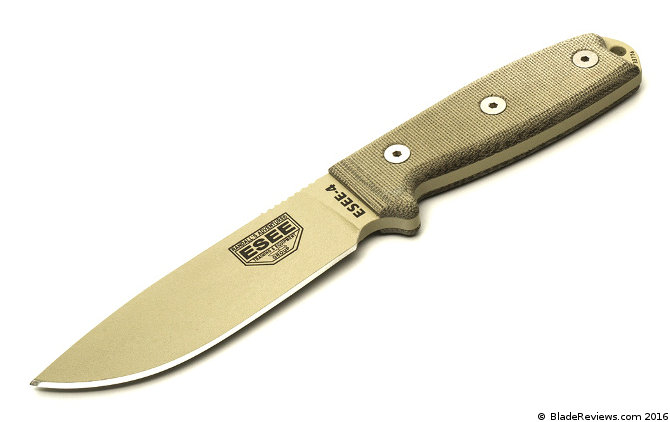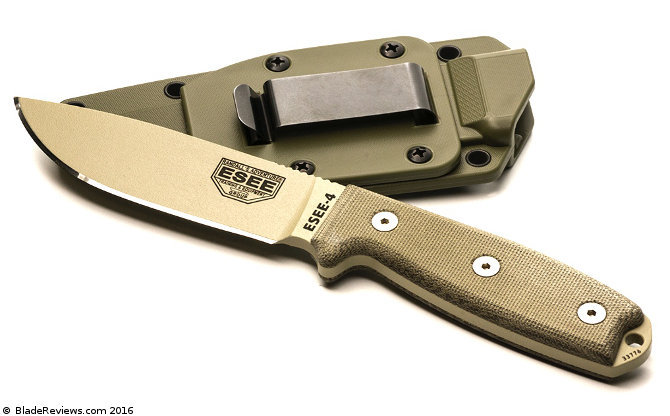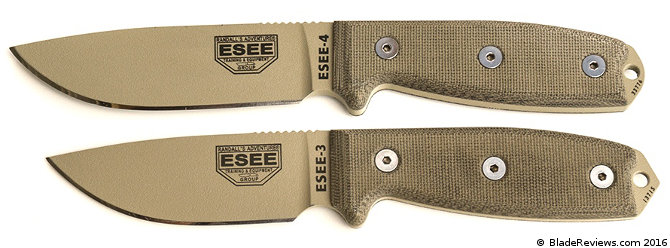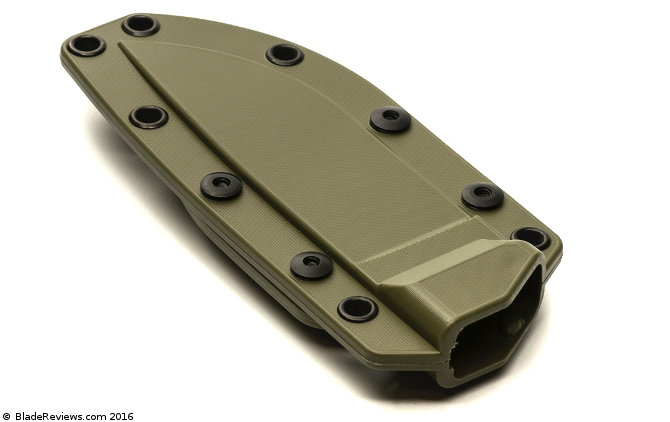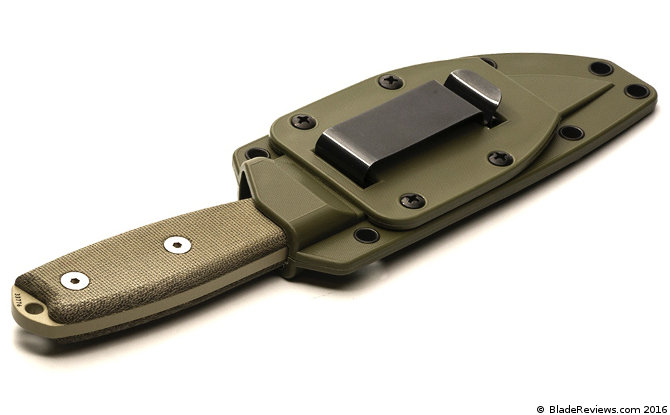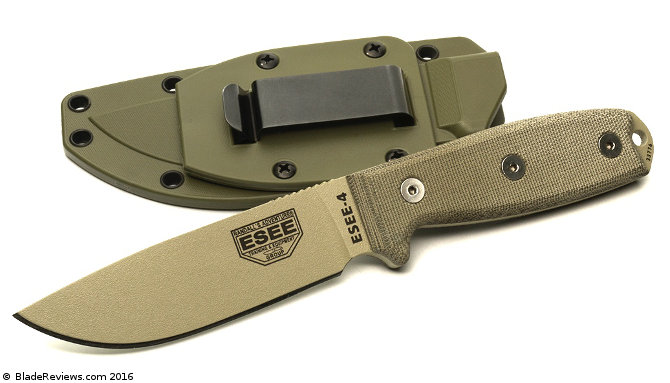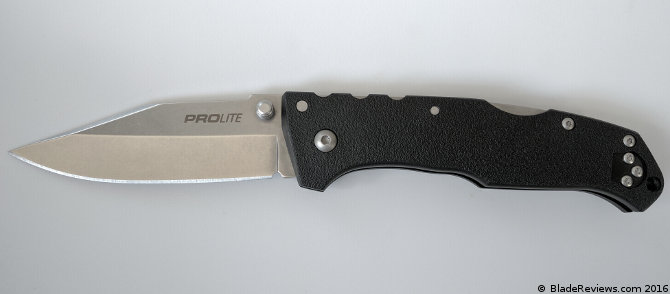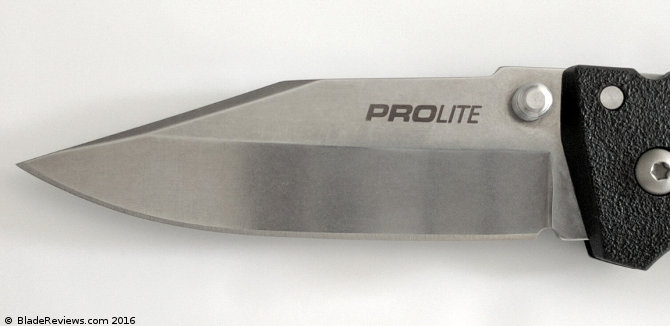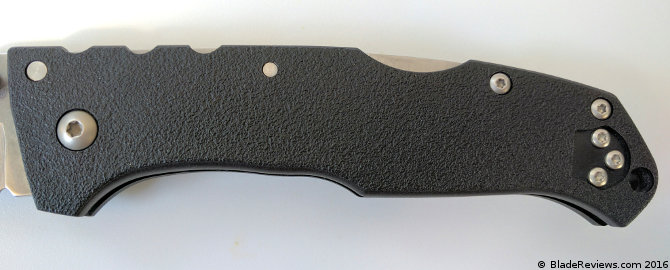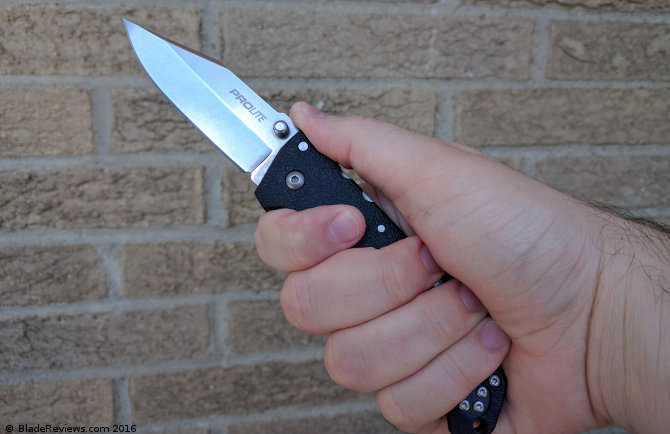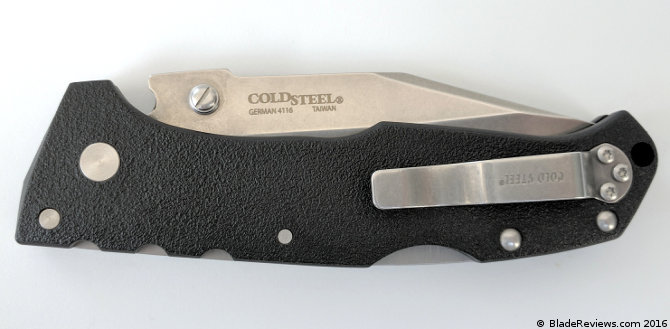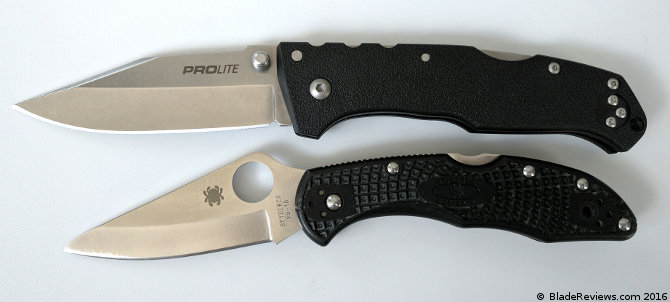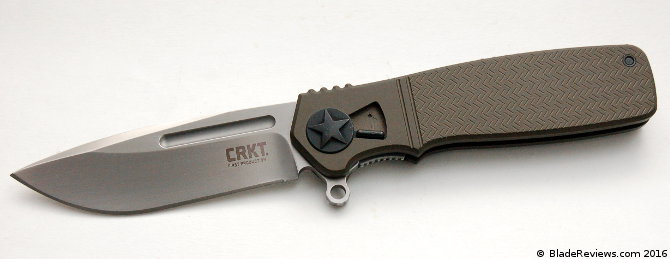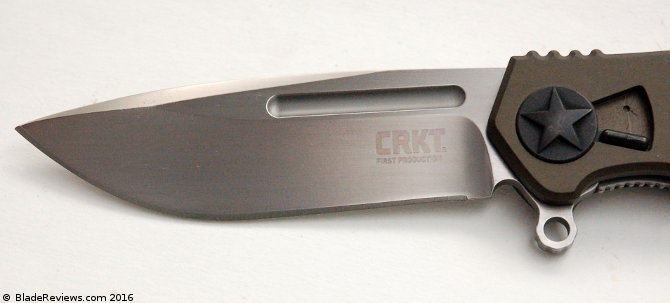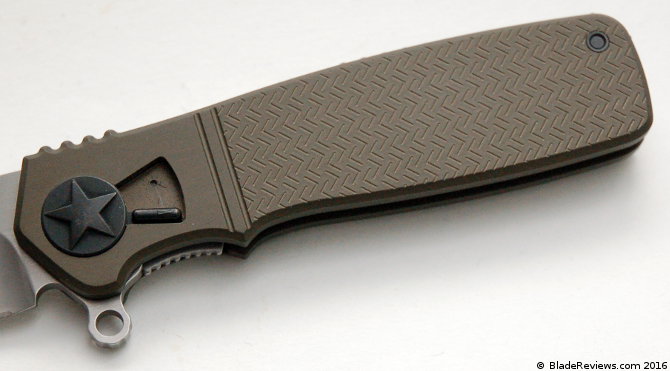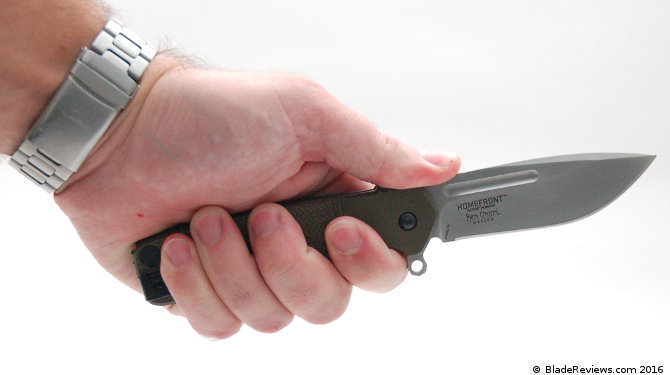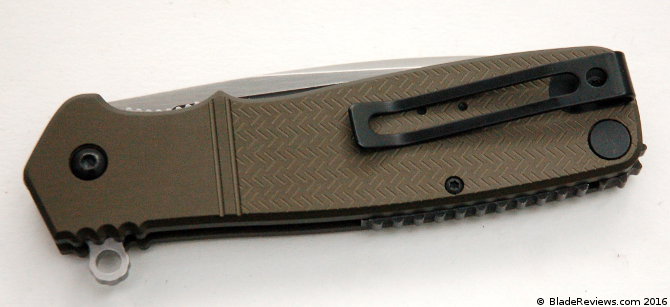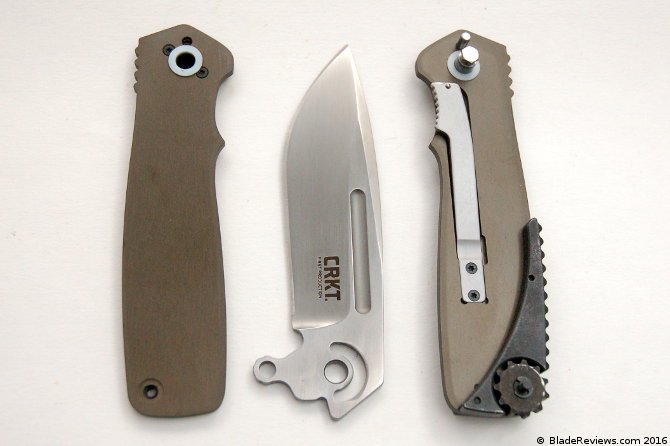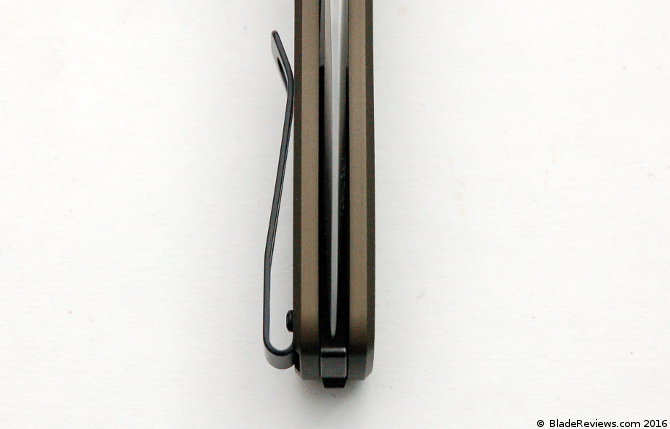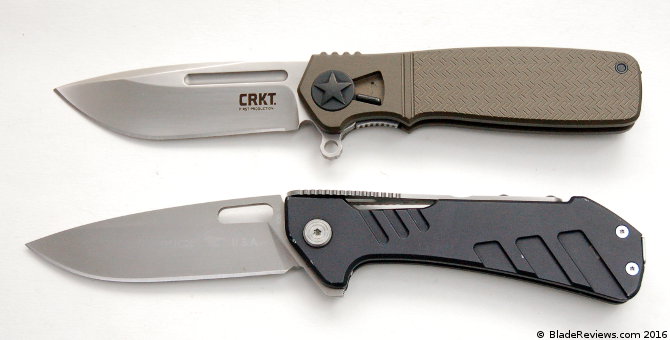Last Updated: August 26, 2019
Hogue is something of an odd brand in the knife industry. Despite their award winning designs, the Hogue line has never really caught on with the majority of the knife community. It could be that they produce button locks whereas consumers [think that they] want framelocks. Or perhaps the market is too caught up in the frenzy over flippers. Whatever the reason, Hogue is a company that rarely gets the praise or online attention it deserves.
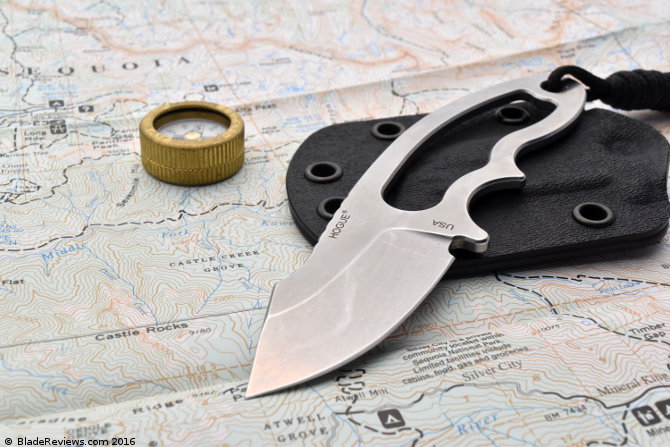
Buy the Hogue EX-F03 at BladeHQ
Like its brethren, the EX-F03 is not a trendy knife. Pictures of it won’t clog your Instagram feed. BladeHQ won’t generate a feeding frenzy by announcing a shipment of EX-F03’s has arrived. It certainly won’t scratch the itch behind the EDC top and the torq bar. At the end of the day, it’s a working knife in a market driven by collectors and aficionados. As a collector (and a nonstop fidgeter) I’m guilty of both sins. Whatever the case, the EX-F03 seems to have slipped under the radar. Hopefully this review remedies that.
Before the review really begins in earnest, there’s a bit of a cautionary tale/PSA I should share. Always check state and local laws before purchasing a knife. CA Penal Code 21310 forbids carrying a concealed “dirk or dagger,” which I belatedly discovered applies to all fixed blades. It cuts me deeply that I can’t carry a knife that I [spoiler alert] really like outside of my home. What really twists the blade is that this was a gift from my girlfriend. I’d like to say that it being a gift hasn’t affected this review, but she reads my work here, and I’d rather keep my blood inside of my body.
General Dimensions and Blade Details
Out of the sheath, the Hogue EX-F03 has a cutting edge of 2.25”, an overall length of 5.5”, and a weight of 2.1 oz. In the sheath, the knife is 6.5” long, 2.5” wide, and weighs just under 4 oz. The blade stock is .16” thick. Judging by size alone, the design intent of the EX-F03 is a small utility blade. It’s also available as a dedicated belt knife, which includes a screw-on handle with a karambit style ring incorporated. Of note is that the aforementioned belt version includes the neck sheath as well. Both handle styles of the EX-F03 are available with a hawkbill blade, if you’re so inclined.
The EX-F03 has what Hogue calls a clip point. It doesn’t look like any clip point I’ve ever seen, but one thing’s for sure: the folks at Hogue know how to manage a grind. It’s even and crisp, and the blade stock is thin enough that it cuts well. The blade is a bit short for food preparation, and I’ve learned the hard way that stubby blades can be hazardous at times. Pro tip: don’t try and slice a palmed apple with something this size. It doesn’t end well.
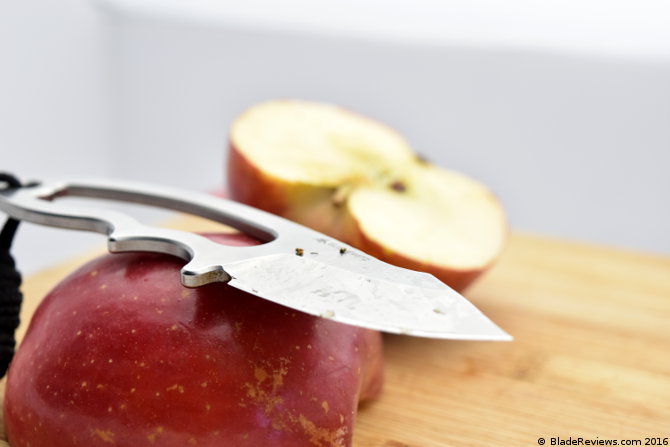
At first I thought the tip was too thin, but some pretty extensive use has shown me the error of my ways. It’s not as durable as an ESEE or a Becker, but I found the thin tip perfect for working with tough materials that tend to bind, such as foam board. Conversely, I was a big fan of the continuous belly on the EX-F03 in theory, but in practice it tends to slip out of the aforementioned tough cutting mediums. Not that it’s a poor cutter – quite the opposite – but some finesse may be required.
Here is a picture of the tip of the EX-F03 compared to the Paramilitary 2:
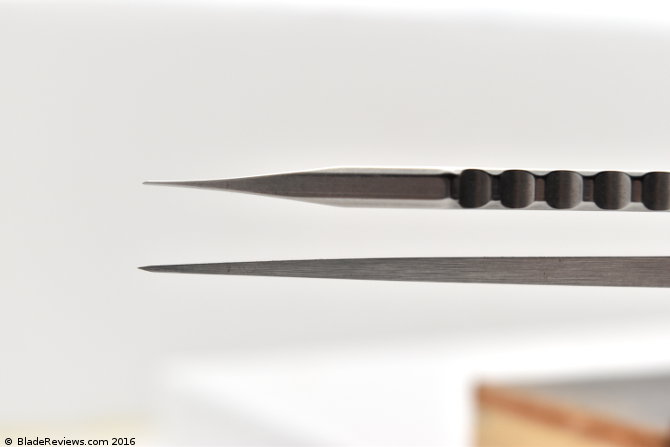
Hogue uses 154CM for most of their blades. It’s a steel I prefer on any serious work knife, as its blend of toughness, edge retention, rust resistance, and ease of maintenance make it well suited for any given task on the job site. It doesn’t shrug off abuse like 1095, but it doesn’t chip near as often as S30V. Regular stropping keeps the edge keen, and I’ve never had a problem with tarnishing or rust spots. This particular knife has been used on drywall, cardboard, and more than a few clamshell packages without any problems. The true sharpening choil makes for headache-free maintenance. And yes, it did all of this:
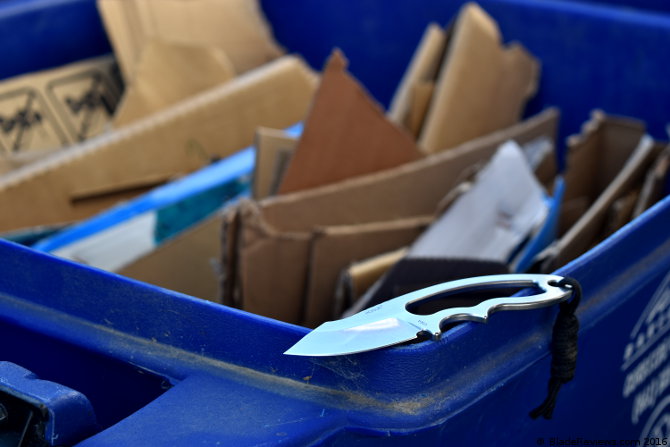
Handle and Ergonomics
The EX-F03’s skeletonized construction is as simple as you can get. As such, the EX-F03 really has only one problem: it’s too thin. Yeah, I know. Go figure. Remarks from Captain Obvious aside, without the presence of some contouring, harder cuts press the tang into the palm, which in turn generates some discomfort. That said, I’m looking for a knife that fits into my pocket comfortably, and the extended grip is too long for that. If you have access to some basic tools, you could theoretically purchase the full version and grind off the ring (Allen Elishewitz spoke about doing just that). Bear in mind, that sort of action will void your warranty.
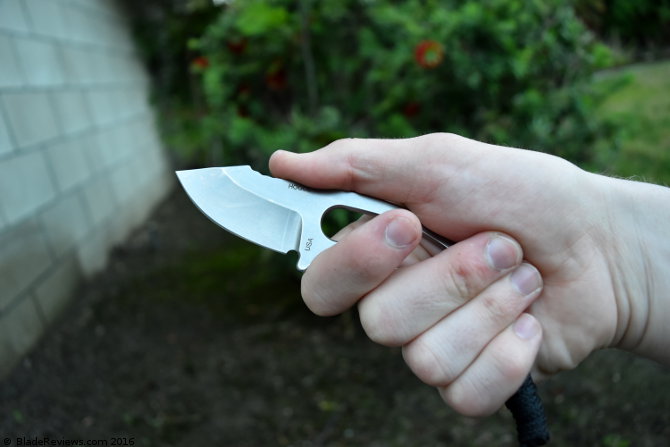
All that said, I like the overall design. It’s a 3-finger grip, but the included lanyard gives your pinky something to hold onto. The curves of the handle, although thin, nestle organically into the palm. And I have to hand it to Hogue’s machinists: they made a bare piece of steel as comfortable as they could. Everything is chamfered and polished. The jimping is hands-down some of the nicest I’ve experienced, with thick, rounded ridges that lock your thumb in place without generating hotspots.
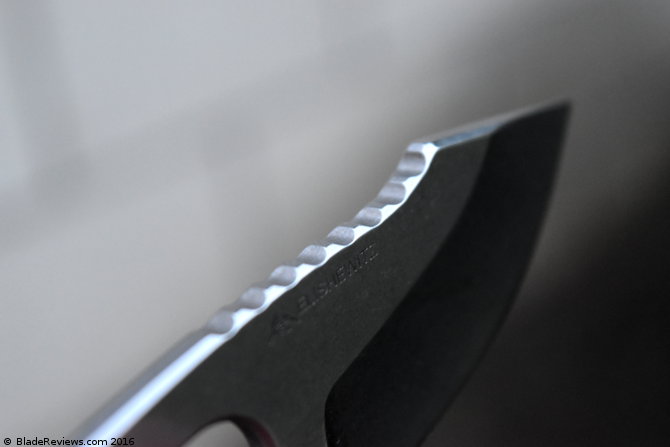
It all boils down to intended use: if you want to carry a fixed blade in your pocket (rather than on your belt), chances are you value discretion and ease of carry as much or more than the ergonomics. If you do need a blade that can handle prolonged use, it’s probable that you can carry said knife on your belt without rubbing anyone the wrong way.
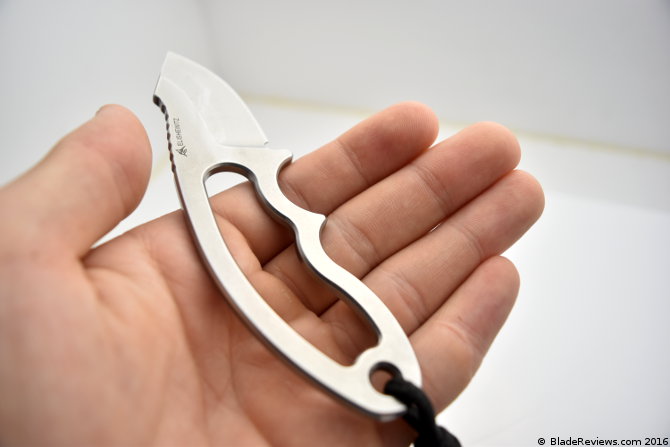
Sheath
The sheath of the EX-F03 is truly sublime. Apart from a loose rivet – which Hogue fixed promptly – I have no complaints. If you keep up with Gear Geeks Live, you’ll have an idea how rare that is. There is a firm snap upon sheathing and unsheathing the blade, and no wiggle in any direction while stored. It’s made of Boltaron, which is similar to but slightly tougher than Kydex. I own a couple custom fixed blades and have handled my fair share of productions, and this sheath outclasses all of them. Through some witchcraft, it’s bidirectional and accommodates both blade shapes. One slight downside: you can (with some effort) pop the sheath off with your thumb, but for me it’s mostly a two-handed affair. I don’t know if that’s a deal breaker for some, but I don’t mind.
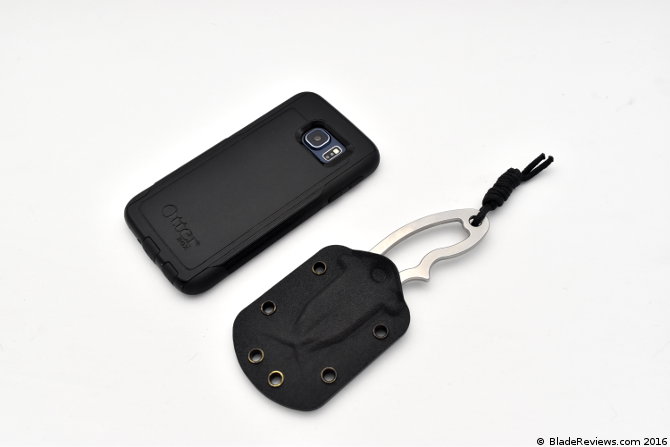
As shipped the EX-F03 is a neck knife. While I’m reasonably certain that it would serve well in such a role, I don’t work in an environment where that would be appropriate. For the sake of due diligence, I wore it around my neck once or twice, and it worked fine. Deployment was easy and the cord was comfortable. Even so, the cord was removed at the earliest opportunity. To my delight I found that the EX-F03 carries wonderfully in the pocket. The sheath is wide enough that the blade doesn’t roll or bind in the pocket, and rounded enough to fit into a variety of pants without issue. On a few weekend trips up into the woods, I wore it on my belt with a spare Tek-Lok I had lying around, and it worked fine. The dedicated belt sheath is clearly superior, but in a pinch this did the trick.
Hogue EX-F03 Review – Final Thoughts
All told, the EX-F03 is an impressive addition to the Hogue line. By now you should be able to tell I’m overly picky, so of course my jimmies will be rustled by the little things. (Hell, if you don’t see a complaint, call the authorities. It may be a cry for help.) The few flaws present are honestly quibbles, and can’t hold back what I think is a strong competitor in the world of fixed blades.
Speaking of competition: the price point of the EX-F03 is a major departure for Hogue. Typically their knives clock in at $150 and up, but this configuration of the EX-F03 costs just under $70.00. Some may still consider this expensive for a small fixed blade. Depending on what extras you want, the ESEE Izula falls at a similar price point, but I think the costlier steel and stellar sheath are well worth the price of admission for the Hogue.
If you’re looking for a pocket fixed blade, you should start here. Much like traditional knives, a good carry option determines if the knife in question actually gets pocket time. In this regard, the EX-F03 is unmatched. I couldn’t fault anyone for looking elsewhere, and the competition is very strong, but the sheath of the EX-F03 is so well-suited to pocket carry that it at least should be part of the conversation. Whether you’re a veteran to the world of fixed blades, or a green recruit, I can wholeheartedly recommend giving the EX-F03 a chance. If you live in California, well…shell out for the belt sheath. I’ve heard good things.
- Package length: 2.4 cm
- Package width: 7.2 cm
- Package height: 17.0 cm
- Product Type: SPORTING GOODS
Editor: If you are thinking of buying a Hogue EX-F03, please consider purchasing it at Amazon or BladeHQ. Thanks for reading.
